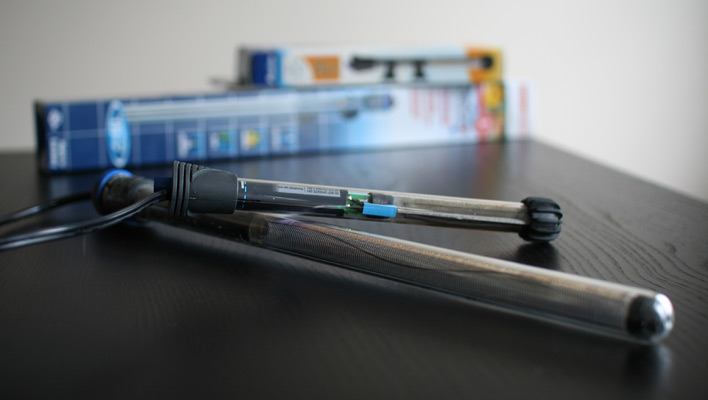The vast majority of saltwater aquarium hobbyists choose to keep fish and invertebrates that were collected on and around tropical coral reefs. Thus, if they want to keep their marine livestock alive and thriving, it’s essential that they maintain tropical temperatures in their tanks. The good news is, owing to the ready availability of high-quality, affordable aquarium heaters and thermometers, maintaining the right water temperature is a snap.
What’s the correct range?
Opinions vary when it comes to the ideal water temperature for a saltwater aquarium. Here at Saltwater Smarts, we recommend a temperature in the range of 76 to 80 degrees Fahrenheit. The exact value you settle upon within that range isn’t critical, but it is very important to keep it stable, as sudden, pronounced temperature fluctuations are extremely stressful to reef organisms.
The right tools for temperature maintenance
The heat-control workhorse of the saltwater-aquarium world is the submersible heater. We suggest choosing a model that is fully submersible versus the style designed to hang on the rim of the tank. Submersible heaters (we use EHEIM Jager models) give you much more flexibility when it comes to placement because they can be positioned in virtually any orientation. Be sure whatever model you choose is both easy to read and simple to adjust.
For the sake of aesthetics, you can creatively conceal your heater in the display tank, for example behind live rock, or you can leave it out of the display tank altogether and put it down in your sump instead.
If you plan to keep a boisterous fish species prone to trashing heaters and other equipment, such as a triggerfish, sump placement of the heater is highly recommended. If that’s not an option, you should choose a shatterproof heater, such as a titanium model or one encased within a plastic sheath.
Of course, you’ll also need to monitor your water temperature on a regular basis, ideally using either a floating thermometer (these are typically equipped with suction cups so they can be affixed to any smooth surface in your system) or a digital remote sensor with a temperature probe. A temperature check should be performed every day, so if you choose to place the thermometer out of sight in a sump, overflow compartment, refugium, etc., make sure you can easily access it.
How much heating power?
As a general rule, your aquarium heater should provide between 3 and 5 watts of heating power per gallon of aquarium capacity. So, if you have a 40-gallon tank, your heater should be rated for somewhere between 120 and 200 watts, depending on the prevailing ambient temperature in the vicinity of the aquarium.
TIP: Double up for big tanks
With larger aquariums, it’s a good idea to use two heaters, each rated at approximately half the recommended wattage, instead of just one. This way, you’ll have more even heat distribution throughout the tank, and if one heater should break, you’ll still have another in operation to prevent a major temperature plunge while you head to the store to buy a replacement.




I would advocate an external thermostat connected to titanium heaters as the best and most reliable form of heating your aquarium.. If you do want a heater thermostat then do not skimp on one and buy a good respected make. Many suggest you change your heater thermostat every 2 years to reduce the chance of failure. The required wattage is best split into two heater thermostats that way if one should fail and stick on it will take some time to overheat your aquarium if at all and you are more likely to spot the failure. Likewise, if one fails and won’t come on at least the other will help keep some heat in the tank until you can buy another. Better still keep a spare heater for such emergencies as sods law will dictate a heater will fail at the most inconvenient time.
So with two heaters… Do you set them both to the desired temp, say 77 or do you stagger them say 77 and 76?
I would suggest staggering the temperature settings. Then the second heater will turn on when the first heater isn’t able to support the desired temp.
In my Carib system, I utilize two 300w Jager heaters. Their temperature settings are staggered AND I utilize a controller to turn on/off each of them depending on the temperature range I want the tank to stay within (currently 76-77 degrees). As the system is located in my basement, ambient air temps are much more stable. During the summer, one heater is easily able to maintain the system within the specified threshold. During the colder months, the secondary heater is activated more often to keep water temp within that range.
Such a great and informative post on how to maintain our aquarium. In this way, fishes will live longer. Keep posting.